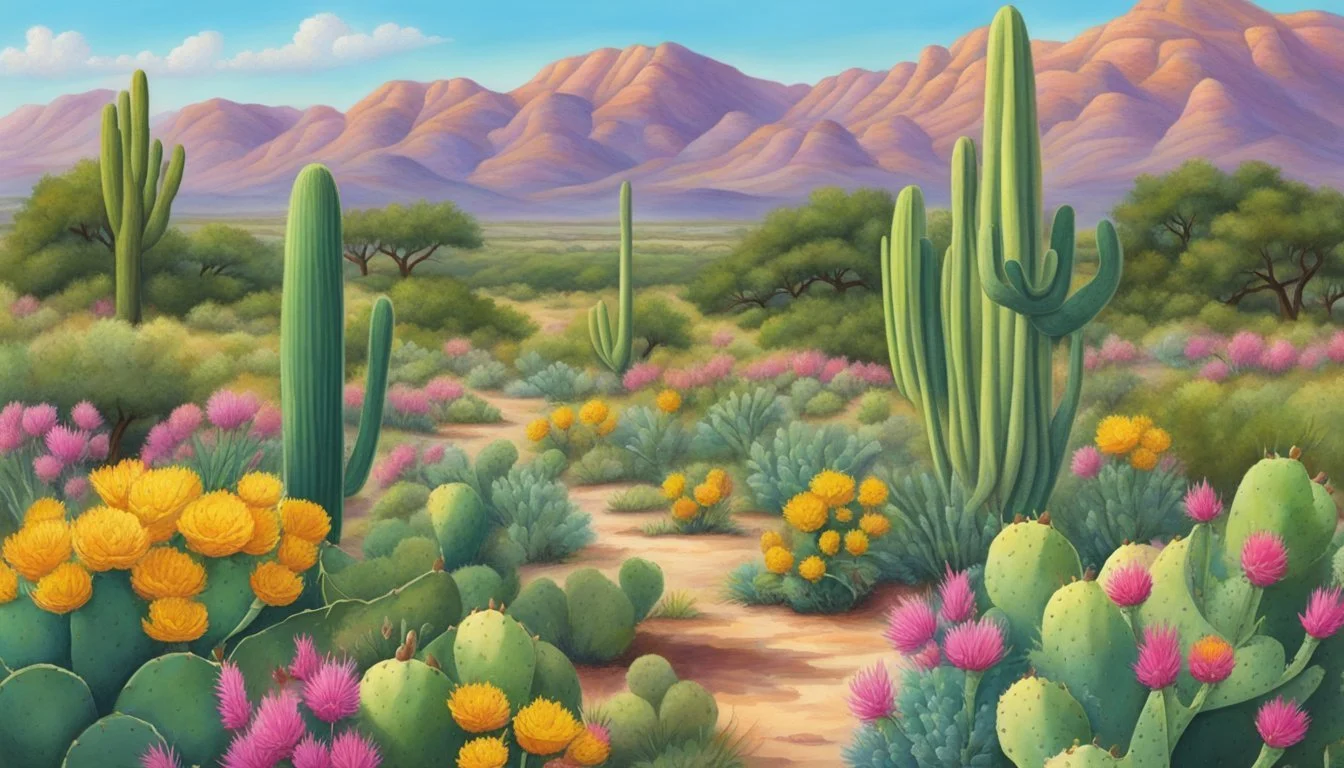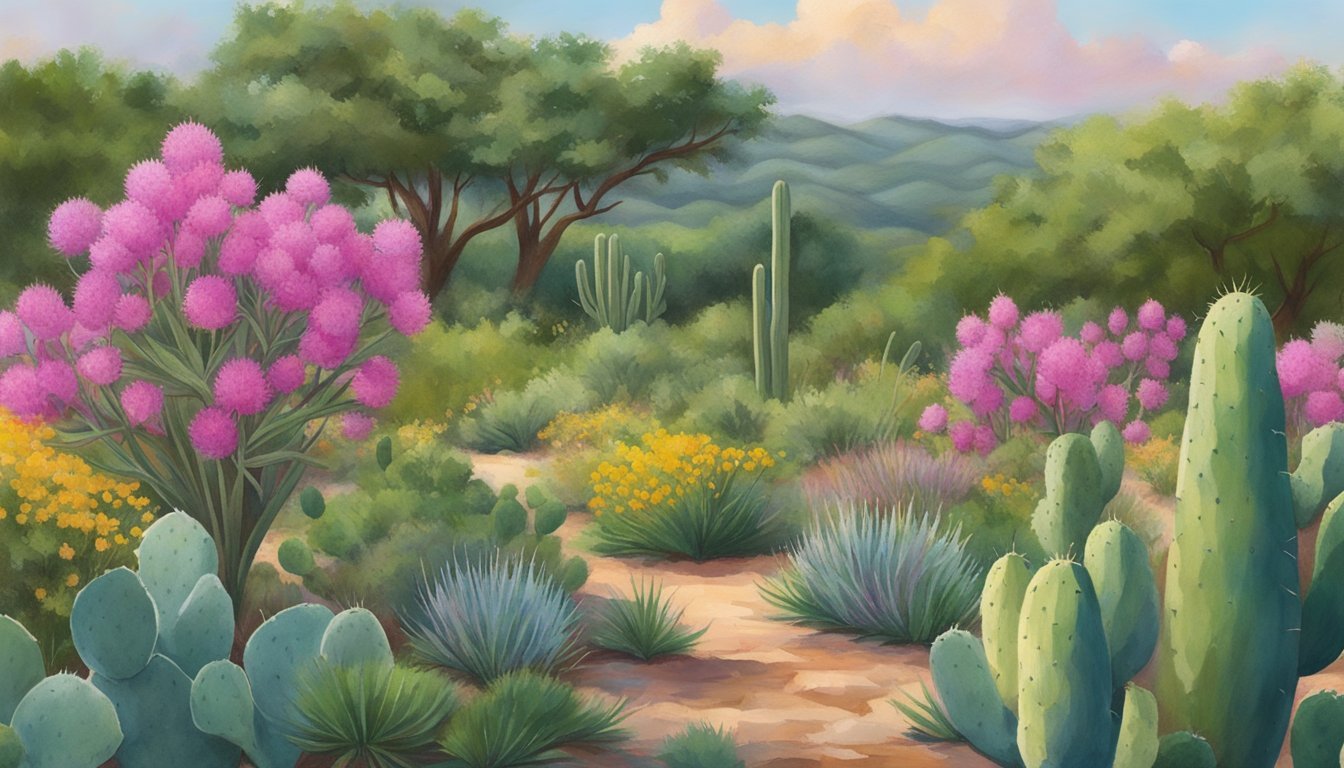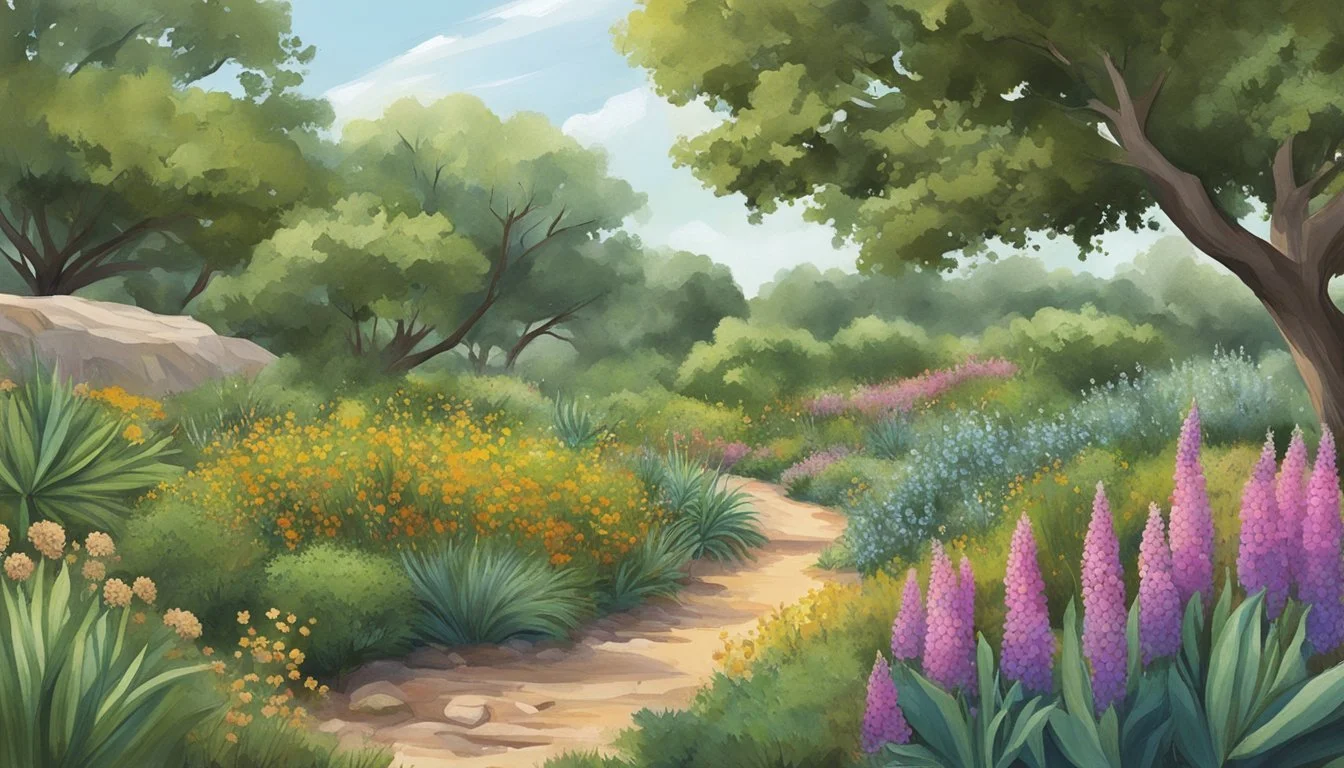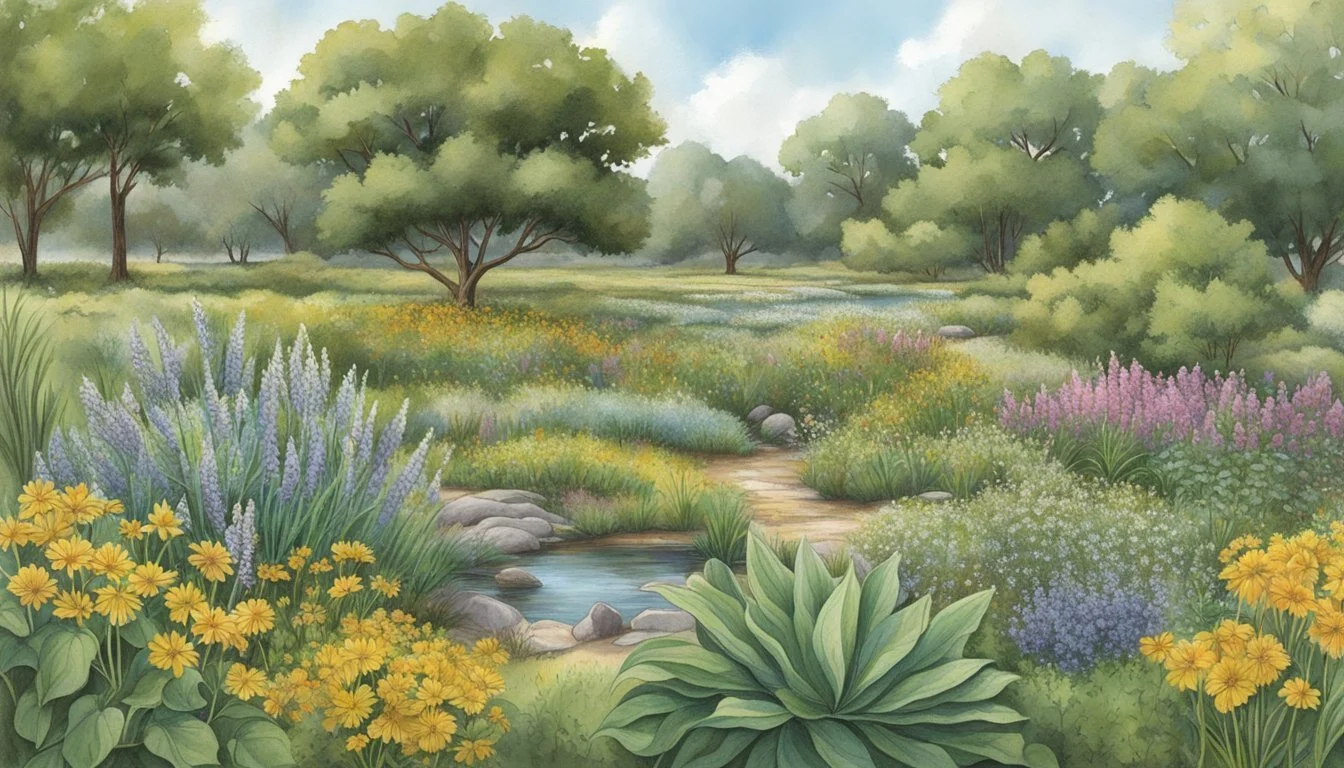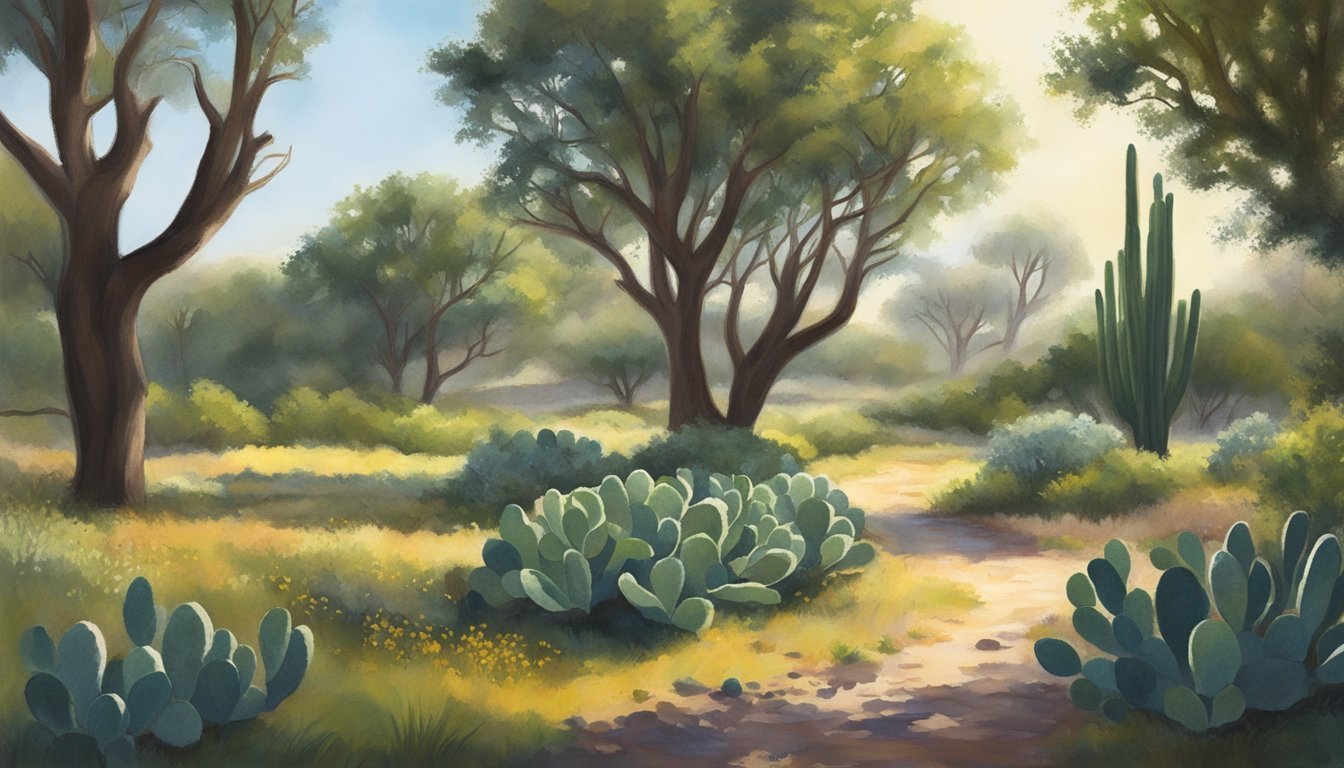Native Edible Plants in Texas
A Guide to Foraging and Cuisine
This Article is Part of Foraging Guide for All 50 US States
Texas, a state with a diverse range of ecosystems, from deserts to forests, is home to an abundance of native plants, many of which are edible. These plants not only offer a variety of flavors and textures to the culinary adventurer but also reflect the rich botanical heritage of the region. Foraging for these plants is a way to connect with the land and understand the natural resources that native peoples have relied on for centuries.
Edible native plants of Texas include a wide range, from prickly pear cacti, known for their sweet fruits and tender pads, to the versatile pecan tree, whose nuts (how long do nuts last?) are a well-known staple. Other plants, such as the dewberry, which grows wild in many parts of the state, provide seasonal berries that can be used in a multitude of recipes. Understanding these plants and their uses not only enriches one's appreciation for the local environment but also opens up opportunities for sustainable and nutritious food sources.
While the allure of foraging can be strong, it's crucial to approach this practice with respect for the land and knowledge of sustainable harvesting techniques. Identification of edible species is key, as some plants can be harmful if misidentified. A responsible forager should be aware of the local laws and regulations regarding plant collection to ensure that these natural treasures are preserved for future generations to enjoy.
Interested in Mushroom Hunting in Texas?
Texas' diverse landscapes, from the Piney Woods to the Hill Country, offer unique opportunities for mushroom hunting. The state is home to edible species like morels, chanterelles, and oyster mushrooms. With proper identification skills and respect for public and private land regulations, foraging in Texas promises an exciting and rewarding experience in the Lone Star State.
Understanding Native Edible Plants
Native edible plants in Texas have a profound impact on the state's culture, ecology, and gastronomy. They provide a unique insight into the natural and human history of the region by serving as a sustainable food source and maintaining the balance of local ecosystems.
Historical and Cultural Significance
Historically, native edible plants have been integral to the diet and culture of indigenous Texas communities. For centuries, plants such as the Opuntia cactus, also known as prickly pear, and the Diospyros texana, or Texas persimmon, have been harvested and utilized for their nutritional and medicinal properties. These plants are not only a staple in traditional recipes but also hold ceremonial and historical value that reflects the rich cultural tapestry of Texas.
Ecological Benefits
From an ecological standpoint, native edible plants are vital for the health of Texas's landscapes. They contribute to the region's biodiversity, supporting a variety of wildlife species as both habitat and food source. For instance, the Carya illinoinensis, or pecan tree, provides nuts that serve as sustenance for small mammals and birds. By fostering these plants, one helps sustain the intricate food webs that are crucial for a robust environment. Native plants are ideally adapted to the local climate and soil, which means they require fewer resources to thrive, reducing the need for irrigation and fertilizers that can be harmful to the surrounding ecosystem.
Foraging Fundamentals
Foraging for native edible plants in Texas requires knowledge of ethical practices and safety measures to ensure both personal wellness and ecosystem integrity.
Ethical Foraging Practices
When foraging, one should gain permission before collecting plants on private land; it is essential to respect property rights. On public land, check local regulations as they can vary, often requiring a foraging permit. Conservation is key; foragers should only take what is needed and leave enough behind for wildlife and plant regeneration. Sustainable harvesting techniques include:
Taking only a small portion of plants found in abundance.
Avoiding the collection of rare or threatened species.
Leaving the smallest possible footprint, being mindful of where one steps to avoid damage to neighboring plants.
Safety Tips and Identifying Poisonous Species
Foragers must be able to identify edible species with certainty and be aware of similar-looking poisonous plants. A reliable field guide can assist in accurate identification. Never consume a plant unless absolutely certain of its safety. Safety tips include:
Washing all foraged items thoroughly to remove potential contaminants.
Learning the characteristics of toxic plants native to Texas.
Using caution when foraging in areas that may have been exposed to pesticides or pollutants.
Poisonous Species Table
Plant Edible Lookalike Toxic Part Notes Water Hemlock Queen Anne's Lace All parts Highly toxic, even in small quantities. Poison Ivy Fragrant Sumac All parts Causes skin irritation upon contact. Deadly Nightshade Black Nightshade All parts Especially toxic berries and foliage.
Foragers should equip themselves with this knowledge to forage responsibly and safely.
Seasonal Guide to Edible Plants
The varying seasons in Texas bring a diverse range of edible plants to the table, offering fresh flavors throughout the year.
Spring Harvest
In spring, one finds a resurgence of life as numerous plants start to thrive under the warm sun. Texans can harvest wild onions, with their distinct sharp flavor, as they begin to sprout across fields and meadows. Additionally, dandelions make their appearance, both their green leaves and yellow flowers are edible, offering a slightly bitter yet nutritious addition to salads.
Wild Onions: Ubiquitous and easy to identify with their slender green stems and white bulbs.
Dandelions: Look for the bright yellow flowers and jagged leaves, both of which can be eaten.
Summer Bounty
As the early summer sun intensifies, a variety of plants reach their prime. Foragers can seek out prickly pear cacti, now with both ripe fruit and tender pads, perfect for a refreshing and exotic summer dish.
Prickly Pear Cactus: Fruit is often bright red or yellow and can be eaten raw or made into jellies; the green pads can be cooked like vegetables.
Fall Foraging
Come fall, the cooler temperatures encourage the growth of different species. Nut-bearing trees begin to drop their bounty, and plants like pawpaws and persimmons ripen, offering sweet and unique flavors.
Pecans (how long do pecans last?): Texas natives often gather these nuts in fall, as they fall naturally from trees and can be used in various recipes or eaten raw.
Persimmons: Easily identified by their bright orange color when ripe, can be eaten fresh or used in desserts.
Winter Finds
In winter, the landscape may seem barren, but for the keen eye, edible plants like chickweed and wild mustards persist. They can be found even in colder months and are excellent for adding a spicy kick to winter meals.
Chickweed: Small, star-shaped flowers with tender leaves, often found in clusters.
Wild Mustards: Look for their yellow flowers and spicy-flavored leaves.
Plant Profiles
Exploring the native edibles of Texas provides insights into a diverse array of plants that offer both nutritional and medicinal benefits. From the prickly cacti to the luscious berries, each category of plants plays a role in the natural and dietary landscape of the region.
Cacti and Succulents
Prickly Pear (Opuntia spp.): This cactus is easily recognized by its flat, fleshy pads that are covered with spines. The pads (nopales) and fruit (tunas) are edible; they're rich in vitamins and can be eaten raw, grilled, or boiled.
Cactus: There are various edible cactus species in Texas. They typically contain significant moisture and are often consumed for their tasty and nutritious fruit.
Herbs and Greens
Dandelion (Taraxacum officinale): Often dismissed as a weed, the dandelion's leaves are high in vitamins A, C, and K, and can be added to salads or cooked greens.
Chickweed (Stellaria media): This herb is commonly found in cooler weather and can be eaten raw or cooked, offering a mild, spinach-like flavor.
Horehound (Marrubium vulgare): Horehound leaves are traditionally used for their medicinal properties, specifically in candies and cough remedies.
Fruits and Berries
Dewberries (Rubus spp.): Related to blackberries, they grow wild in Texas and can be enjoyed raw, in jams, or in baked goods.
Texas Persimmon (Diospyros texana): This tree yields a small, black fruit with a rich, sweet flavor when ripe. They're a good source of vitamin C and fiber.
Agarita (Mahonia trifoliolata): This shrub bears tart, red berries that can be made into jellies and wines.
Roots and Tubers
Wild Root: Various wild roots in Texas are edible, including those from the sassafras and wild onion plants. They're often used in traditional cooking and remedies.
Roots: Edible roots from local plants can be roasted, boiled, or eaten raw, and are packed with essential nutrients.
Trees and Shrubs
Pecan (Carya illinoinensis): The state tree of Texas provides nutritious nuts that are rich in healthy fats, proteins, and antioxidants.
Mexican Plum (Prunus mexicana): This tree produces plums that can be eaten fresh or used in preserves.
Jujube (Ziziphus jujuba): Introduced, but naturalized in Texas, this tree bears fruit that is rich in vitamin C and can be eaten fresh or dried.
Culinary Applications
Texas's native edible plants offer a variety of tastes and textures that can enrich a wide range of culinary creations. They provide unique flavors and nutritional benefits frequently sought after by both home cooks and professional chefs.
Preparation and Cooking Methods
When preparing native Texan plants, it is important to first identify and clean them properly to ensure they are safe for consumption. Many native leaves and flowers can be raw or lightly blanched, adding vibrant flavors and textures to salads. For example, the leaves of the spiderwort plant can be used in salads for a slight crunch.
Preparation Method Plant Examples Culinary Use Raw Spiderwort, Prickly Pear Salads, Smoothies Steamed or Boiled Dandelion Greens, Amaranth (how long does amaranth last?) Side Dishes, Soups Blanched Lamb's Quarters Pesto, Salads Fermented Wild Mustard Seeds (how long do mustard seeds last?) Preserves
Native fruits and berries can be cooked down to make syrups or preserves. The mustang grape, for example, can be used in sauces or reduced into a syrup for desserts. Texas persimmons and prickly pear fruits are also popular for making syrups and sweet wine.
Recipes and Preservation
The versatility of Texas' native plants lends itself well to an array of recipes. Dewberries can be transformed into a tangy preserves, capturing their flavor long past their season. Prickly pear fruits are excellent for both sweet and savory applications, from making a vibrant syrup for cocktails or pancakes to a wine that showcases its delicate, fruity essence.
Texans often enjoy Yaupon Holly leaves brewed into a rich, caffeinated tea, which holds a sacred place in local culinary traditions. Meanwhile, local chefs may incorporate Lamb's Quarters into a fresh pesto, taking advantage of its nutty flavor and abundant nutrients.
Here are specific ways to preserve and utilize these plants in culinary applications:
Mustang Grape Wine: Ferment the juice with a suitable yeast to create a robust homemade wine.
Dewberry Preserves: Simmer berries with sugar and lemon for a spreadable preserve ideal for toasts and pastries.
Prickly Pear Syrup: Juice the ripe fruits and reduce with sugar to produce a syrup for flavoring beverages or drizzling over desserts.
Yaupon Holly Tea: Dry and roast the leaves, then steep them to make a stimulating tea enjoyed hot or iced.
Health Benefits and Nutritional Value
Native edible plants in Texas offer an array of health benefits due to their nutritional compositions. They often contain essential vitamins and minerals that play crucial roles in maintaining bodily functions. For instance, cactus pads, also known as nopal, are rich in fiber and may assist in regulating cholesterol levels.
Pecans, native to Texas, are highly nutritious and provide a good source of antioxidants. These compounds help to combat oxidative stress and may reduce the risk for chronic diseases. Pecans are also dense in minerals like magnesium and zinc.
Prickly pear fruit is recognized for its vitamin C content, a powerful antioxidant that supports the immune system. Additionally, the fruit offers magnesium and potassium, beneficial for heart health and muscle function.
Wild onions found in Texas offer both nutritional and medicinal qualities. They contain vitamin C, dietary fiber, and several antioxidants, and have been used for their potential to alleviate cold symptoms.
Here is a brief overview of the nutritional benefits of several Texas native plants:
Plant Nutrients Potential Health Benefits Cactus (Nopal) Fiber, Calcium, Vitamin C Lowers cholesterol, blood sugar regulation Pecan Antioxidants, Vitamin E, Minerals Heart health, reduces oxidative stress Prickly Pear Vitamin C, Magnesium, Potassium Immune support, heart health Wild Onions Vitamin C, Fiber, Antioxidants Cold relief, digestive health
One must incorporate these native edible plants into their diet mindfully, ensuring a balance with other nutrients required for a holistic diet.
Supporting Texas Wildlife
Native edible plants play a significant role in sustaining a diverse range of species across Texas. These plants not only provide nourishment but also crucial habitats for local wildlife.
Attracting Pollinators and Birds
Pollinators such as bees, butterflies, and hummingbirds are essential for the health of many plant species, and thus, for the ecosystems as a whole. To attract these beneficial creatures, it's important to grow native plants like:
Milkweed: Specifically attracts monarch butterflies by providing food for caterpillars and nectar for adults.
Goldenrod: Offers nectar for a variety of bees and butterflies.
Birds greatly benefit from the presence of native plants which provide both food in the form of seeds, nectar, and insects as well as nesting materials and shelter. Examples include:
Mesquite: Its seeds are a food source for various bird species.
Texas Mountain Laurel: Provides dense foliage for nesting sites.
Using these specific plants in gardens and landscapes can greatly boost the local populations of both pollinators and birds.
Habitat Conservation
Habitat conservation is critical for the survival of wildlife. Native plants are well-adapted to Texas's climate and soil, reducing the need for additional water or fertilizers which can be harmful to the environment. Conserving and restoring habitats with native plants supports wildlife by:
Providing shelter: Dense shrubs and trees offer protection and breeding grounds.
Ensuring a food supply: Fruits, seeds, and leaves of native plants cater to the diverse dietary needs of wildlife.
By maintaining healthy ecosystems with native flora, Texas ensures that it remains a thriving environment for a variety of species including birds, butterflies, and other pollinators.
Gardening with Native Edible Plants
Gardening with native edible plants offers numerous benefits for Texas landscapes. These plants are well-adapted to the region's climate and soil conditions, often requiring less water and maintenance than non-native species. They also provide habitats for local wildlife and contribute to biodiversity.
When incorporating native edibles into a garden, consider the following:
Sunlight and Shade: Optimize plant health by matching the light preferences of each species to the garden's conditions.
Soil Type: Use native plants suited to the garden's soil type, whether it be sandy, loamy, or clay.
Popular Native Edible Plants for Texas Gardens:
Plant Edible Parts Sunlight Soil Preference Pecan (Carya illinoinensis) Nuts Full to partial Well-drained, fertile Texas Persimmon (Diospyros texana) Fruit Full to partial Well-drained, sandy or rocky Prickly Pear Cactus (Opuntia spp.) Fruit and pads (nopales) Full Dry, well-drained Dewberry (Rubus trivialis) Berries Partial shade Well-drained, sandy loam
Choosing Plants:
Match plants to the specific ecoregion in Texas to enhance success rates.
Introduce a variety of species to create an ecologically stable garden.
Consider seasonal growth and harvest times to ensure year-round benefits.
Place taller plants like pecan trees to the north of smaller ones to prevent shading.
Group plants with similar water needs together to optimize irrigation.
Use native grasses or groundcovers to prevent soil erosion and retain moisture.
Gardening with native edible plants is an effective way to create a sustainable and productive landscape in Texas. These plants often require fewer resources and support the local ecosystem more than their non-native counterparts.
Legal and Conservation Considerations
In Texas, foraging for native edible plants comes with responsibilities to both adhere to legal frameworks and to participate in conservation efforts. These stewardship practices ensure the sustainability of plant populations and habitats.
Foraging on Public vs. Private Land
Public Land: Foraging on public land in Texas requires individuals to follow state and federal regulations. Certain areas, such as state parks and natural reserves, may have specific rules or may prohibit foraging altogether in an effort to protect native species and ecosystems. It is crucial for foragers to check with local authorities before harvesting plants.
Permit Requirements: Some public lands may require a permit for foraging; always verify current regulations.
Designated Foraging Areas: Some public lands may have designated areas where foraging is permitted; these may include areas like the Lost Pines region.
Private Land: Foraging on private land in Texas is permissible only with explicit permission from the landowner. Trespassing to forage is illegal and can result in prosecution. Landowners may implement their own rules for sustainable foraging practices on their property.
Landowner Agreement: Always obtain written permission to forage on private land.
Respecting Boundaries: Foragers must respect property boundaries and the landowner's conservation efforts.
Conservation Efforts and Sustainable Practices
Conservation organizations and government agencies in Texas actively work to preserve the state's native flora. They implement various initiatives that often include public education on sustainable foraging practices to avoid overharvesting and habitat destruction.
Key Conservation Strategies:
Educational Programs: These programs aim to inform the public about the importance of plant conservation.
Sustainable Foraging Guidelines:
Harvest only what will be used to prevent waste.
Do not take rare or endangered species.
Use non-destructive harvesting techniques to ensure plant regeneration.
The Lost Pines area, a unique eco-region in Texas, is particularly vulnerable and requires special consideration to prevent the degradation of its ecosystem. Conservation measures here are essential to protect and sustain the natural habitat and its indigenous plant species.
Further Resources
Finding comprehensive resources is crucial for anyone looking to identify and utilize native edible plants in Texas. Utilizing reliable field guides, connecting with experts through workshops, and partaking in foraging tours can greatly enhance one's knowledge and application of this subject.
Field Guides and Literature
Title Description Availability Texas Foraging Comprehensive guide on native plants, including edible species. Bookstores, Online Edible Wild Plants of Texas A focused look on the edible plants specifically found in Texas. Libraries, Online Lady Bird Johnson Wildflower Center Publications Various resources covering Texas flora, with emphasis on native species. Wildflower Center, Online
In addition to the above, many local bookshops and online retailers offer a selection of region-specific field guides and literature that delve into the diverse flora of Texas. It's recommended to check at area farmers markets, as well, since they occasionally have books and pamphlets about local edible plants.
Local Workshops and Foraging Tours
Farmers Markets:
Farmers markets often host workshops that include lessons in identifying and cooking with local edible plants.
Check the schedules of nearby markets for upcoming events.
Foraging Tour Groups:
Guided Educational Tours:
Tour groups offer hands-on experiences for those interested in learning directly in the field.
These tours provide a practical approach to identifying edible plants, with expert guidance.
Educational Centers:
Foraging and Plant Identification Classes:
Places like the Lady Bird Johnson Wildflower Center offer classes and field opportunities focusing on native plant life.
They provide a structured environment for learning, with the added benefit of their extensive knowledge and resources.
Conclusion
The diverse landscapes of Texas, affectionately known as the Lone Star State, provide a rich repository of native edible plants. These plants not only offer sustenance but also carry a heritage that connects the land to its people.
Prickly Pear Cactus: thrives in arid regions, its fruit and pads are edible.
Pecan: Texas state tree, offers nutritious nuts.
Mesquite: its pods, once ground, yield a sweet, flour-like substance.
The knowledge about these plants is not merely academic but has practical applications in sustainable food practices and nature conservation efforts within the state. Individuals and communities are increasingly recognizing the value of these plants.
Foragers and nature enthusiasts are advised to remain responsible and respectful towards the ecosystems. Proper identification of plants is crucial, as is an understanding of sustainable harvesting techniques to ensure that these precious resources remain available for generations to come.
In summary, native Texas plants contribute significantly to the region's culinary and cultural identity. They hold promise for ecological health, food diversity, and a deeper appreciation of the natural world bridging past, present, and future.

